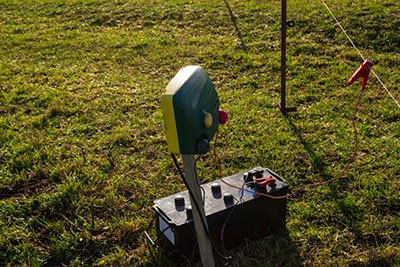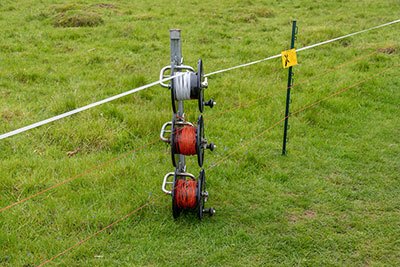Are you looking to upgrade your electric fence installation? Do you want a safe and efficient way to keep animals off your property or protect your crops as well? Then look no further because installing a proper ground system is the answer.
This method of fencing uses grounded rods that are connected by cables providing an electrical pulse when touched and can be installed without too much hassle.
In this guide, we’ll walk through the steps of how to install an electric fence ground rod so you can get started on securing a safe perimeter for yourself!
Take away key points:
- You can use copper rods to ensure the charge passes through the charged wires and maximum power
- With the grounding system, there won’t be stray voltage and you can contain your animals more effectively
- You can find all the necessary tools in the hardware stores and ensure the best soil conditions for effective electric fencing systems. Otherwise, you may encounter a non-electrified fence and you cannot protect your animals well.
Table of Contents
- A full guide to good electric fence grounding: All you must know
- FAQs
- How far should a ground rod be for an electric fence?
- Do I need 3 ground rods for the electric fence?
- How deep should a ground rod be installed?
- Can you use rebar as a grounding rod for an electric fence?
- Why do ground rods have to be 6 feet apart?
- What size wire do you use for ground on an electric fence?
- What factors will affect the ground system of an electric fence?
- What gauge wire for electric fence ground?
- Conclusion
A full guide to good electric fence grounding: All you must know
If you need to know more about how to properly install a good ground system for your electric fences, follow the procedure below.
We will explain how to install ground rods for your fence line in detail.
What is proper grounding for electric fences & why is it important?

Proper grounding for electric fences is an important part of ensuring that the fence works correctly. It involves installing three grounding rods or more grounding rods, which should be about 10 feet apart and can be made of copper or galvanized steel.
The purpose of the grounding rods is to provide a path for electricity to travel through to shock the animal without the current traveling underground. The grounding system helps protect both the animal and any nearby people or objects from potential harm.
Additionally, having multiple ground rods increases the number of electron receptors, making it easier for electricity to flow through the fence.
Overall, a proper grounding circuit for electric fences is essential to ensure that they work effectively and safely. Without it, there is a risk of malfunctioning or even injury due to electric shock.
Electric fence ground rod recommendations
A common guideline is to place at least 3 feet long ground rod units per joule of output capacity. For instance, a 15-joule electric fence charger will necessitate no less than 45 feet of ground rod. The grounding rods must be installed a minimum of 10 feet apart from each other.
How can I tell if my fence has a properly ground terminal?
A grounding system is essential to ensure it functions correctly. A good grounding circuit consists of three 6-8 foot long grounding rod units, ground rod clamps, and 20 KV insulated hook-up wire.
The larger the power output of a fence charger, the more grounding rod units you will need. A general rule is to use a minimum of three feet of grounding rod per joule of output from the energizer for the properly grounded fences.
To test your fence grounding system, you can use a voltage meter or tester to measure the voltage at each end of the fence line and each ground rod. If all readings are similar, then your electric fencing has good grounding rods.
If you notice different numbers in the readings, you will have improper grounding, and your electric current cannot work optimally if the animal touches the fence wire. So, you need the right electric current to contain cattle and other livestock from predators.
Installing an electric fence earth stake: A full procedure
Below you can find grounding tips to install ground rods for your fences:
Pre-step: Tool preparation
Installing ground rods in electric fences requires some preparation. You will need:
– a sledgehammer,
– hammer drill to drive the rods into the soil.
Additionally, you should have at least three 6-foot-long ground rods and a ground wire clamp for connecting the rods to your fence energizer. It is also recommended to install 90 cm (3′) of the ground rod below the water line for maximum efficiency.
Step 1: Find the best location
Select a location near the charger box and away from other grounding systems such as the home. Make sure that the ground rod will be in contact with enough soil moisture to complete the electric current and conduct electricity to the ground terminal.
Step 2: Place enough rods and a proper distance
Pound in the correct number of 6-foot-long ground rod units at least 5 feet apart from each other. The first grounding rod should be driven into the soil within 20 feet of the fence energizer.
Step 3: Add an insulated wire
Connect multiple ground rods using insulated wire, making sure that all connections are secure and tight.
Step 4: Attach the wire to the ground rods

Use a clamp or connector to attach one end of the ground wires to each of your ground rods, and then connect them with another piece of insulated wire.
Step 5: Add a surge protector
Attach a lightning arrester (also known as a surge protector) between two of your rods, and make sure it is securely connected to both ground wires with insulated wire or cable ties. This will help protect your electric fencing from lightning strikes and power surges.
Step 6: Add grounding material for extra safety
Finally, use an appropriate amount of grounding material such as copper mesh or stainless steel mesh around each rod. It covers at least 3 feet below grade level and extends up above grade level by at least 3 inches (7 cm).
This will help ensure that your electric fence system is properly grounded and safe from electrical shock hazards or malfunctions due to poor grounding conditions.
FAQs
How far should a ground rod be for an electric fence?
They should be about ten feet apart for the ground wire to work optimally.
Do I need 3 ground rods for the electric fence?
Yes, you will need at least three rods for the fence charger and a proper fence wire system.
How deep should a ground rod be installed?
It should be eight feet deep (2.4 m).
Can you use rebar as a grounding rod for an electric fence?
Yes, you can use a pipe or rebar in most cases.
Why do ground rods have to be 6 feet apart?

If you place them too close, they will interfere with each other, so there won’t be enough electricity.
What size wire do you use for ground on an electric fence?
You should use 0.5 or 0.75 inches of fence wire.
What factors will affect the ground system of an electric fence?
The main factors affecting the electrical charge include:
– The type of livestock or predators being controlled
– The conductivity of the soil (rocky soils, soil moisture, etc.)
– The capacity of the energizer to produce an electrical charge
What gauge wire for electric fence ground?
You should use a 12.5 fence wire gauge.
Conclusion
Ensuring an efficient grounding system is incredibly important to the effectiveness of fences. Without it, those charged wires are not able to do the job; thwarting predators away from your livestock.
It’s therefore paramount to invest in quality ground rods and other materials needed for a reliable grounding system. That way you can entrust your animals are as secure as possible and that all electric fencing installation efforts were worth it in the end.
